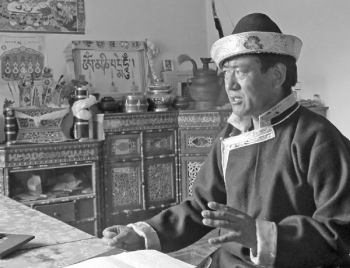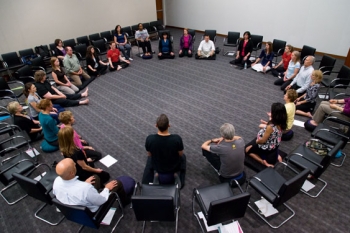Twenty years ago, Tsering was a fully ordained monk in Tibet. Now, 40-year-old Tsering is a farmer and businessman in China. When his sister fell gravely ill, Tsering left Ganden monastery (belonging to the Gelukpa school of Tibetan Buddhism) at the age of 22 to pursue a life where there was an income and a profit. Hailing from Tibet’s Maizhokunggar County, Tsering was ordained at the age of 14, and was devoted to his monastic life. One of his past masters recalls that Tsering had “one meal each day and observed 253 religious disciplines to make himself a better monk” (China Daily).
Tsering’s sister’s health improved, yet his return to the monastery never happened. Believing that he had “broken his vows,” Tsering decided to continue his life as a farmer. However, the Buddhist beliefs and practices he has known since the age of 14 have never left him. “The education I received in the monastery influenced me greatly. Though I have changed my life’s role I have never stopped reading my scriptures,” he says. With a view to helping others, Tsering now employs 15 villagers to work in his fields, has started a medicinal herb business with the support of a few other families, and has about 40 investors in his oil mill. He expects to generate a large return for this year’s business. But Tsering also provides spiritual solace for those who seek it. “Becoming rich is not my only goal. Happiness is more important to me, and I feel happiness whenever I help others,” explains the former monk.
So, is it possible to take the principal teachings from the 2,500-year-old religion and apply them in a world where numbers and profits rule and business ethics are preferably kept behind locked doors?
A religion like Buddhism may indeed be able to positively affect this relentless economic drive. In a HuffPost blog, Beth Burgess, a therapist, author, and trainer, suggests that a few Buddhist teachings could benefit the workforce very positively. Happier employees lead to greater productivity, leading in turn to a healthier, more cohesive environment. Burgess bases her discussion on the threefold division of the Noble Eightfold Path (the fourth of the Noble Truths, the foundational teachings of the Buddha, who believed that it was the way to reduce suffering and gain spiritual awakening): intelligent discrimination, or wisdom (P. panna; Skt. prajna), which encompasses “right view” and “right intention”; ethical conduct (P. sila; Skt. shila), which includes “right speech,” “right action,” and “right livelihood”; and concentration (P. and Skt. samadhi), comprising “right effort,” “right mindfulness,” and “right concentration.”
Through intelligent discrimination, one can realize the impermanence and interconnectedness of all phenomena. Increasing one’s flexibility, adaptability, and acceptance of change are useful characteristics to build in a workforce. Burgess adds that a workforce attaining panna can generate better “creativity, teamwork and co-operation as colleagues learn not to attach to their own ideas or fixed ways of doing things, and to share their successes with others.” Ethical conduct is predictably a huge factor in the workplace and among employees. Consideration for others and prevention of harm are of great importance if a business is to run ethically. A company which shows solid ethical conduct, CSR (corporate social responsibility), and genuine willingness to provide consumers with the best is bound to have a good reputation in the community. Lastly, Burgess pinpoints concentration as a viable strategy for businesses to adopt. Striving to improve, being mindful of progress, developing greater awareness, and aiming to develop are important attitudes that will benefit any business. With the right concentration, workers can also manage stress and time better. Burgess explains, “In the process of training the mind, workers learn to overcome hindrances to concentration, such as laziness, torpor and a wandering mind.”
The author also claims that large businesses like Apple, Google, and Procter & Gamble have implemented mindfulness meditation in the workplace to try and combat employee stress. According to a blog for HuffPost Business by Bill George, a professor of management practice at Harvard Business School and the CEO of Medtronic, in 2012 Google implemented a program called “Search Inside Yourself,” which promotes emotional intelligence in employees through meditation. Chade-Meng Tan, the Google engineer that designed the program, created it to help employees cope with Google’s intense environment. “Mr. Tan's program is very popular among employees, generating a waiting list each time it's offered,” says George. He also writes about General Mills, who encourage their workers to practice meditation, yoga, and mindfulness at work. The company reported that 80 per cent of their employees had better clarity and decision-making ability and that 89 per cent claimed to have better listening skills.
Disney was perhaps one of the earliest companies to use Buddhist practices to create a healthy environment in the workplace. According to business website FastCompany.com, 30 years ago Disney hired psychotherapist, clinical trainer, author, and meditation teacher Ronald Alexander to lead seminars for two years. He worked on the employees’ creativity and re-visioning skills, and later on these workers, aptly called “Imagineers,” went on to design the Disneylands in Tokyo, Paris, and Hong Kong. Alexander says, “Mindfulness helps you to build what I call mind strength. Your awareness and consciousness become really toned. This is an excellent strategy for becoming successful in your profession, as well as the bigger game of transforming yourself and the people who work with and for you.”
In this fast-paced world, a happy employee is often a rare employee. Incorporating Buddhism in business might be a breakthrough to more mindful, ethical, and happier workplaces, where sustainable productivity supersedes tedious office hours.
“The most valuable service is one rendered to our fellow humans”—from a plaque attached to a tree in Wat Phra Sing Buddhist temple, Chiang Mai, Thailand.
For further information, see:

















